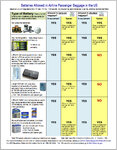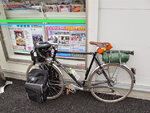Hi guys, recently a few people have reached out regarding flying on commercial airlines with electric bikes and their large Lithium-ion batteries. I've done some preliminary research and wanted to share for feedback and to hear what has worked for you.
My understanding is that Lithium-ion batteries between 100 to 300 watt hours are permitted as carry on luggage as long as they fit inside your luggage. I've used the advanced search tool on EBR to show all of the ebikes I've reviewed with batteries < 300 watt hours but note, not all of them will have the dimensions to fit inside your checked bags. Here is the Federal Aviation Administration (FAA) source I am referencing and below is a short snippet from it.
For those of you who would prefer to check the large, heavy battery of your electric bike, the FAA stipulates that the battery must be installed in the device but protected from accidental activation. Some electric scooters (like the Glion) actually come with physical cutoff switches to satisfy this requirement. Unfortunately, for large Lithium-ion batteries you are not permitted to check them outside of equipment. I've attached the original FAA .pdf along with a screenshot of their chart that details each battery type and size with associated carry on vs. check approval status:

I recently reviewed the EcoReco M5 and YouTube member Mikeykaysuper made the following comments about his experience flying with the EcoReco M3 (which has nearly the same design and the same sized battery).
My understanding is that Lithium-ion batteries between 100 to 300 watt hours are permitted as carry on luggage as long as they fit inside your luggage. I've used the advanced search tool on EBR to show all of the ebikes I've reviewed with batteries < 300 watt hours but note, not all of them will have the dimensions to fit inside your checked bags. Here is the Federal Aviation Administration (FAA) source I am referencing and below is a short snippet from it.
Passengers can also bring two (2) larger lithium-ion batteries (more than 8 less than 25 grams of equivalent lithium content per battery or about 100-300 watt hours per battery) in their carry-on. This size covers the largest aftermarket extended-life laptop batteries and most lithium-ion batteries for professional-grade audio/visual equipment. Most lithium-ion batteries are below this size.
For those of you who would prefer to check the large, heavy battery of your electric bike, the FAA stipulates that the battery must be installed in the device but protected from accidental activation. Some electric scooters (like the Glion) actually come with physical cutoff switches to satisfy this requirement. Unfortunately, for large Lithium-ion batteries you are not permitted to check them outside of equipment. I've attached the original FAA .pdf along with a screenshot of their chart that details each battery type and size with associated carry on vs. check approval status:

I recently reviewed the EcoReco M5 and YouTube member Mikeykaysuper made the following comments about his experience flying with the EcoReco M3 (which has nearly the same design and the same sized battery).
I have taken my M3 on three airline trips on Southwest and Icelandair and had no problem putting it on as a checked bag. I informed them that it was 300 watt hours and the battery was not readily remove able, I bought a solid wheeled golf case that the M3 fits into perfect and it makes transporting it easy and it is very protected . . . The case is ~$200.00 but is real tough and the scooter fits folded up and with the front wheel turned. When they ask to look at it at the check in counter it just takes a second to unlock and open it. I had a tough time the first trip I made with the scooter in the original box because the airline required me to open and remove the scooter so they could see it and it took about twenty minutes and than they wanted customs fees when I got overseas. So now with the golf case it is much easier, here's the one I got: SKB 2SKB-4812WS ATA Standard Golf Travel Case on Amazon.
Attachments
Last edited by a moderator:





